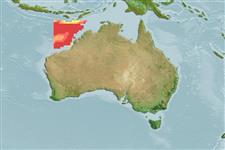>
Acropomatiformes (Oceanic basses) >
Malakichthyidae (Temperate ocean-basses)
Etymology: Malakichthys: Greek, malakia = softness + Greek, ichthys = fish (Ref. 45335); levis: Named for the absence of tooth-like spines on the chin ('levis' = beardless)..
Environment: milieu / climate zone / depth range / distribution range
Ekologi
laut batipelagis; kisaran kedalaman 143 - 256 m (Ref. 44351). Tropical; 11°S - 21°S, 116°E - 126°E (Ref. 57279)
Eastern Indian Ocean: northern Australia, from the North West Cape, Western Australia to Cape Arnhem, Northern Territory.
Size / Weight / umur
Maturity: Lm ? range ? - ? cm
Max length : 15.9 cm SL jantan/; (Ref. 44351)
deskripsi pendek
Morfologi | Morfometrik
Duri dubur 3; Sirip dubur lunak: 8. This species is distinct in having the following characters: no paired spines on chin; proximal-middle radial of first anal-fin pterygiophore is broad with cone-shaped hollow lacking lamellar septum; well developed lateral wing; A III, 8; pectoral-fin rays 14; gill rakers on lower arm 20-23; 49-53 scales on lateral line; 5-7 transverse scale rows above lateral line; body depth 26-35% SL (Ref. 76883).
Life cycle and mating behavior
Kematangan | Reproduksi, perkembang biakan | Pemijahan | telur-telur | Fecundity | Larva
Yamanoue, Y. and K. Matsuura, 2002. Descriptions of two new acropomatid species of the genus Malakichthys (Teleostei: Perciformes) from Australia. Bull. Mar. Sci. 69(3):1139-1147. (Ref. 44351)
Status IUCN Red List (Ref. 130435)
ancaman kepada manusia
Harmless
penggunaan manusia
informasi lanjut
Nama-nama umumSinonim (persamaan)metabolismePemangsaEkotoksikologiReproduksi, perkembang biakanKematanganPemijahanSpawning aggregationFecunditytelur-telurpekembangan telor
Umur / SaizPertumbuhanpanjang-beratpanjang-panjangukuran frekuensiMorfometrikMorfologiLarvaDinamika larvapemulihanKelimpahanBRUVS
AcuanBudidaya airprofil budidaya airStrainGenetikaElectrophoresesDiturunkanPenyakit-penyakitPengolahanNutrientsMass conversion
mitraGambarStamps, Coins Misc.Suara-suaraCiguateraKecepatanTipe renangArea insangOtolithsOtakPenglihatan / visi
Alat, peralatan
laporan khas
muat turun XML
Sumber internet
Estimates based on models
Preferred temperature (Ref.
123201): 16.8 - 20.4, mean 20.4 °C (based on 8 cells).
Phylogenetic diversity index (Ref.
82804): PD
50 = 0.5078 [Uniqueness, from 0.5 = low to 2.0 = high].
Bayesian length-weight: a=0.00479 (0.00182 - 0.01257), b=3.12 (2.89 - 3.35), in cm total length, based on LWR estimates for this (Sub)family-body shape (Ref.
93245).
Trophic level (Ref.
69278): 3.7 ±0.5 se; based on size and trophs of closest relatives
Fishing Vulnerability (Ref.
59153): Low vulnerability (10 of 100).
